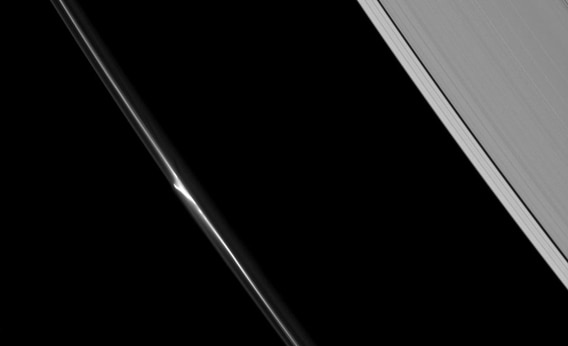Create a free profile to get unlimited access to exclusive videos, sweepstakes, and more!
A Collision in Saturn’s Rings

Our solar system is a big place. Big enough that itâs overwhelmingly empty of stuff. You can travel for billions of kilometers and your chances of smacking into something bigger than a dust particle are very close to zero.
But given enough time, and enough stuff, eventually collisions do happen. It helps if you have a big target, too. A really, really big target. Like, say, Saturnâs rings.
Saturnâs rings arenât solid: Theyâre composed of countless tiny particles of ice. If a piece of interplanetary debris slams into them, it creates a plume that can stretch for thousands of kilometers. Weâve actually seen this happen, but only a few times; the Cassini spacecraft has returned fewer than a dozen instances of these collisions in the nine years itâs been circling the ringed planet.
But it just saw another. On June 20, 2013, the probe snapped the photo above of a collision in Saturnâs thin outermost discrete ring, called the F-ring.
The ring is only a few hundred kilometers wide, making it a narrow target. Still, something whacked it pretty well, creating that trail (also nicknamed a âminijetâ). These trails are formed by low-speed collisions (and by "low-speed", I mean around the velocity of a rifle bullet or faster; "slow" takes on a different meaning when you're talking orbital mechanics), probably from a chunk of rock or ice already orbiting Saturn, following a path slightly more elliptical and/or slightly tilted with respect to the rings. Like two cars going around a racetrack, theyâre both traveling quite rapidly, but relative to each other one passes the other somewhat slowly.
Amazingly, this isnât the first time the F ring has been hit. In August 2009 there was an even more dramatic impact, one of the first seen (more were discovered later in older pictures). Itâs odd that such a narrow target would get hit so often compared to the broader rings, but it may be an issue of contrast: A hit in the thin ring is far easier to spot against the black of space than one in the wider rings, where you see it against the background of the rings themselves.
The impact events are interesting scientifically, since they can tell us about the frequency of collisions in the outer solar system, the average size of the objects involved (assuming we see enough collisions to get some decent statistics), and how the rings react to such an event (the debris cloud gets stretched out and sheared by orbital effects).
But there is also just something compelling about them, too. And itâs more than just the idea of cosmic impacts occurring with wild abandon in space because explosions are cool. Itâs the very idea that such forces continue to work in space all the time, that things change, that a system as magnificent and vast as Saturnâs rings actually experience sudden and dramatic effects like this.
When I was a kid, I would read novels about colonies in the outer planets, excursions by intrepid astronauts to the exotic rings of Saturn. Now I can see pictures like this and realize that what used to be fiction is not necessarily always so. What I would give to see an event like this unfold in real time in front of my eyes, as I hang in front of a viewport orbiting Saturn itselfâ¦


























